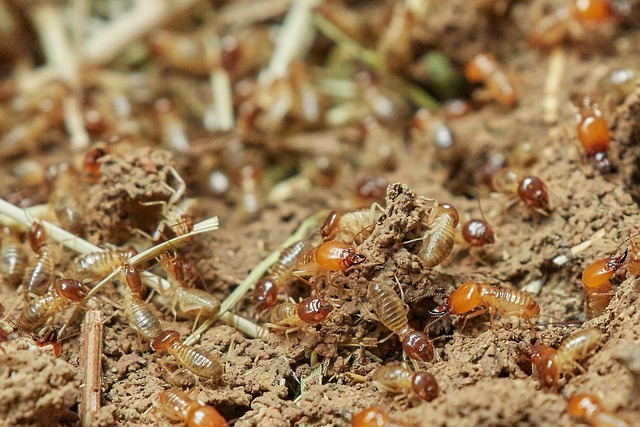Termites pose a significant threat to homes, causing extensive structural damage over time. Regular termite inspections are crucial for early detection and prevention. Professionals use advanced tools and techniques to scrutinize properties for signs of infestation, providing detailed reports with tailored treatment recommendations. Ignoring these checks can lead to costly repairs and compromised home integrity. Debunking myths about termite inspections encourages proactive protection, ensuring peace of mind for homeowners.
“Protecting your property from invisible threats is key to avoiding costly repairs. This article delves into the crucial topic of comprehensive termite inspections, a vital step in safeguarding your investment. We explore why these inspections are essential, dissecting the potential havoc termites can wreak. Learn about the meticulous process, from initial assessments to advanced tools used to identify infestations early. By understanding key focus areas and debunking common misconceptions, homeowners can make informed decisions regarding termite prevention and control.”
Understanding Termite Damage and Its Impact

Termites are silent intruders that can cause significant damage to homes and structures if left undetected. Understanding termite damage is crucial for anyone considering a termite inspection. These insects feed on cellulose, which is found in wood and paper products, making your home an attractive target. Over time, termites can destroy wooden beams, floorboards, and even the structural integrity of a building.
A comprehensive termite inspection is essential to identifying potential problems early. During this process, professionals search for signs of termite activity, including mud tubes, swarmer wings, or dead wood. By assessing the extent of damage and the presence of these indicators, experts can determine if an infestation exists and recommend effective treatment options. Regular inspections are key to protecting your investment and mitigating the devastating impact that termites can have on your property.
Why Regular Termite Inspections Are Essential

Regular termite inspections are an integral part of home maintenance, offering protection against one of the most insidious and costly pests. Termites can cause significant structural damage over time, often going unnoticed until it’s too late. A termite inspection provides a comprehensive assessment of your property, identifying any signs of infestation or potential entry points.
By scheduling these inspections at regular intervals, homeowners can stay ahead of the problem. It allows for early detection of termites, enabling prompt treatment and prevention of extensive damage. Moreover, regular inspections can save you from expensive repairs and ensure the longevity of your home’s structural integrity. This proactive approach is key to maintaining a healthy and safe living environment.
The Process of Conducting a Comprehensive Termite Inspection

A comprehensive termite inspection is a meticulous process that involves several steps to ensure your property is free from these damaging pests. The initial phase includes a thorough visual examination, where experienced inspectors meticulously scan every corner and crevice of the building, looking for signs of termite activity like mud tubes, wood damage, or small holes. This visual assessment provides an initial understanding of potential risks.
Next, targeted areas are probed using specialized tools to detect moisture levels, which attract termites, and any existing termite infestations. Non-invasive methods such as thermal imaging can also be employed to identify hidden problems. Samples may be taken from suspected areas and sent for laboratory analysis to confirm the presence of termites or their droppings, a process known as fecal analysis. These multiple layers of inspection ensure a comprehensive understanding of your property’s termite risk profile, enabling effective treatment if necessary.
Key Areas to Focus During an Inspection

During a comprehensive termite inspection, professionals pay close attention to several key areas to ensure a thorough assessment. One of the primary focuses is the structural elements of your property, including wooden beams, floors, walls, and any other wood-based components. Termites are drawn to these materials, so inspecting them for signs of damage or infestation is crucial. Pay special attention to areas where wood meets soil, as this is a common entry point for termites. Cracks, gaps, or damaged portions of the structure should be carefully examined under ultraviolet light, which can reveal hidden infestations.
Additionally, the inspection should encompass the exterior and interior of your property, looking for evidence of termite activity like mud tubes, swarmer insects, or shed wings. Termite baits and traps are also strategically placed during an inspection to monitor and detect any ongoing infestations. These devices allow professionals to identify active colonies without causing unnecessary damage, making them a valuable tool in the early detection and treatment process for termite inspections.
Tools and Techniques Used in Modern Termite Inspections

Modern termite inspections utilise a variety of sophisticated tools and techniques, vastly different from traditional methods. One of the most important tools is the moisture meter, which helps identify areas with high humidity, as termites are attracted to water. Thermal imaging cameras are also used to detect anomalies in wood structures that may indicate termite activity. These non-invasive methods allow for thorough examinations without causing damage.
Ground penetration radar (GPR) and infrared technology further enhance the process by providing detailed images of underground conditions, helping inspectors identify potential nest locations or voids where termites might be present. Additionally, dog scent detection has shown remarkable accuracy in locating termite infestations, leveraging the powerful sense of smell that dogs possess. These modern techniques ensure comprehensive coverage during termite inspections, enabling professionals to offer better protection for homes and properties.
Interpreting the Inspection Results and Next Steps

After a thorough termite inspection, understanding the results is key to taking appropriate action. The report will highlight areas of concern, potential signs of termite activity, and provide recommendations for further steps. These findings can include details about the type of termites present, their level of infestation, and potential entry points into your property.
The next phase involves prioritizing the recommended treatments based on severity and cost. A professional pest control expert can guide you through this process, offering tailored solutions to mitigate the termite threat. This may involve implementing preventive measures, such as sealing entry points and improving drainage, alongside targeted treatments like local or systemic termiticides to eliminate existing infestations. Regular follow-up inspections are also crucial to ensure ongoing protection against these persistent pests.
Common Misconceptions About Termite Inspections Debunked

Many homeowners often have misconceptions about termite inspections, assuming they are only necessary during initial home purchases or when signs of damage are evident. However, regular termite inspections are a crucial part of maintaining a healthy and safe living environment. Termites can cause significant structural damage over time, making hidden infestations a real concern. One common myth is that inspections are costly and time-consuming, but professionals offer efficient and affordable packages tailored to various needs.
Another misconception is that these checks are only relevant for wooden properties. In reality, any structure with cellulose-based materials is at risk, including modern homes with paper products in their construction. Termite inspectors utilize advanced methods like moisture meters and dog scent detection to identify potential issues early on. Debunking these myths encourages proactive pest control measures, ensuring peace of mind and protecting valuable investments.
